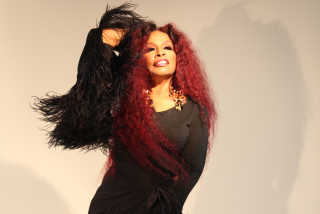Comic Book Super-Hero : Trends: To collector Gary Carter, who turns the pages of first editions with surgical gloves, Superman is up there with Shakespeare. Investors are beginning to agree.
Gary Carter is floating on a comic book collector’s Cloud 9.
Here he is at the famous Sotheby’s auction house headquarters in New York City living out a boyhood dream, elbow-deep in thousands of colorful action-packed renditions of his beloved super-hero tales.
All around him, comic books to kill for. Like Detective Comics 27, the May, 1939, copy that features Batman’s burst onto the comics scene--and into the hearts and minds of small boys everywhere.
There are scores of mint-condition Superman comics from the mid-1950s. And premiere editions of such sensational crime fighters as The Atom and The Human Torch.
Wearing surgical gloves, the 42-year-old Southern Californian and eight other aficionados gently and breathlessly handle each book, consider the whiteness of the paper, the brightness of the ink, the stroke of the artist’s renderings and the strength of the story line.
They look. They touch. They smell. They check for telltale rust on the staples. And they listen for the paper-puckering noise that comes with perhaps the rarest find of all--the first opening of a vintage comic.
As chairman and organizer of the Authenticity Certification Grading Committee, Carter helps evaluate the level of preservation of about 4,000 comics to be sold Dec. 18 at Sotheby’s first comic book auction--which organizers say could be Sotheby’s most popular event ever.
Many of the soon-to-be-auctioned vintage comics will also be on public display Friday and Saturday at Sotheby’s Beverly Hills location.
“All their lives, comics have been treated like second-class citizens,” Carter says. “And suddenly, there we were at Sotheby’s under the shadow of Rembrandt paintings on the wall, grading the condition of a Batman 1 comic book. It’s the most historic event in the history of comic book fandom, a sure sign that comic collecting has come of age.”
These are heady days indeed for the once lowbrow world of comic books.
Thanks to their steady rise in resale value, comics are big business. Along with baseball cards, they’ve become the hottest collectibles around, surpassing stamps and even coins.
As Robin might say to his crime-battling buddy: “Holy solvency, Batman!”
Indeed, a mint-copy 1938 Action Comic 1, worth $300 only 20 years ago, brings more than $100,000 today. People are snatching up old comics on the chance that their increased value will someday provide retirement income.
Some Wall Street portfolios even include comic book investments. Foreign collectors are lining up to get in on the action. As a result, Carter says, the first million-dollar comic isn’t too far off.
After decades of operating in relative obscurity, avid adult collectors like Carter are coming out of the closet--showing off the fruits of childhood obsessions that have evolved into collections of staggering breadth and value.
At last, it’s cool to be crazy about comics.
And the slow-talking Carter, dressed in his blue jeans and pointy cowboy boots, is fast becoming a main character in the Cinderella comic book story.
This year, he and his wife, Lisa, began publishing the Comic Book Marketplace, a fan magazine produced out of their converted garage in Coronado--a monthly labor of love that already has captured 14,000 subscribers, some from as far away as Europe, Japan and Australia.
A part-time English instructor at Southwestern College in Chula Vista, he also free-lances articles on historical aspects of comic book stories and characters.
Wary of possible price gouging in the burgeoning comics industry, Carter also has started an association to set ethical guidelines among dealers for the resale of vintage books.
Over the years, he’s developed a reputation as a comics historian and self-made comic book scholar, which led to his September trip to Sotheby’s in New York. But Carter says he’s first a gee-whiz collector, at heart still the kid who once traded his new bike for a stack of comics.
He collects Golden Age titles from the World War II era, comics featuring a cast of “underwear heroes” such as Superman, Batman and the rest--who in cartoon form illustrated the good-versus-evil themes of the war.
He covets Westerns, war comics, shock comics, science fiction stories, mysteries and romance. And he’s after the Silver Age comics of the 1950s and ‘60s, when super-heroes made their comeback.
If it tells a story in colorful picture frames and shapely word balloons, chances are that Carter has read it. Or owns it.
“I just have this overwhelming love for comic books. I really love them with all my heart,” he says. “I have a deep, abiding respect for them as an art form and as an entertainment and historical mirror.”
In all, he has collected more than 15,000 comics--worth anywhere from a few dollars to, in some cases, more than $50,000. He owns numerous examples of comic book art--works straight off the artist’s easel--and has the world’s most complete collection of DC Comics.
His most valuable treasures are wrapped in plastic, stored in safety deposit boxes. Others are spirited away in a home office he calls the Comic Book Room. Some are so valued that even Carter won’t chance opening them.
“I just want to have them in my collection so I can have access to them at my will, to pick them up and thumb through them--even if it’s 3 o’clock in the morning,” he says. “Because for me, comic books are the greatest escape device--better than television, movies and radio rolled into one.
“For kids, they were the one thing that you could control. They were private and personal. You could get under the covers with a flashlight and go back and reread them and get a charge out of them all over again--just like the first time.”
Heck, Carter can talk about comic books forever. Well, almost.
“I know I could sit around talking for a whole month just about the comics published between 1950 and 1955,” he says. “And the ones that came out during the Second World War--that would take a year to cover.”
The dramatic comic book comeback has given Carter even more to talk about. Like Rodney Dangerfield with a few bent staples, for years comic books got no respect.
They were considered the Sunday funnies in book form, not a legitimate reading effort. And unlike the lofty stamps or coins that are minted to last a lifetime and beyond, comic books were made with the cheapest possible pulp paper.
Folded up in some kid’s back pocket, their high acid content turned them into time bombs that would begin their inevitable yellowing and crumbling the moment they left the dealer’s shop.
Now, perhaps because of such shoddy initial treatment, mint-condition copies of pre-1965 examples are nearly impossible to find--driving up prices, attracting more investors into the game.
Because of the loyalty of collectors, however, most comics stay put once they are purchased. Therefore, available copies are in higher demand, further setting the stage for a market gone amok.
In the still-small world of serious collecting, Carter’s enthusiasm and integrity have begun to pay dividends.
“The comic book industry has gone from a grass-roots hobby to big money, and I’ve seen too many people affected adversely by that money,” says Jerry Weist, a consultant to the Sotheby’s auction.
“There’s just too few people around who have kept that original boyhood love for comics, people who are still the way they were the first day they picked up a comic book. Well, Gary is one of them. You can trust him.”
Carter recalls seeing the first comic book he simply had to own. He was a 7-year-old school kid who walked into a drugstore to spy Showcase 4, the first Flash comic.
“The cover hit me like a bolt of lightning, like a 2-by-4 that whacked me over the head,” he recalls. “It was the most beautiful thing I had ever seen.” Carter bought it--the first comic in his collection--for a dime. “Comics weren’t just a pastime for me, they were a passion. They were living, breathing things I thought about every day of my life. They were a crush, a romance, a childhood obsession.”
Once, as a fifth-grader, after his parents had given his comic collection away to a neighbor because of his bad grades, the boy traded his bike to get the books back.
Soon, he and younger brother Kent began prowling comic book shows in San Diego and Los Angeles to fill holes in their mushrooming collections.
Years later, as college students, the brothers used their last $75 to buy a carload of comics. As a result, for the next six weeks they lived off Bisquick and cherry pie filling. Carter says he hasn’t touched a biscuit since.
Today, joking that he’s known on his block as “that comic book weirdo,” Carter says he’s well aware of the negatives to such obsessive behavior. He’s seen at least a dozen marriages of fellow collectors fall apart. His magazine has featured stories aimed at comic book widows--the spouses of fanatics--discussing the difficulties of living with the collector mentality.
But late at night, secure in his Comic Book Room, Carter climbs back atop his Cloud 9.
He handles his comics cautiously, careful not to open them too fast or too far--for fear of ripping a cover or stretching a binding.
He thinks back to the low point--the days of “Commies and comic books”--to the McCarthy-era Senate hearings that looked into the connection between comics and juvenile delinquency.
Carter also considers the brilliant moments: the two 16-year-olds who in the 1930s dreamed up and illustrated the story of an infant with superhuman powers sent to Earth from the doomed planet Krypton--a name they derived from the periodic table of the elements.
The Superman story, he says, is as important to the literary world as a Shakespearean play, “as important to the 20th Century as H. G. Wells and Jules Verne were to the 19th Century.”
Comics, he says, are as American as eating Popsicles. And he knows there are unexplored worlds out there in Comic Book Land--millions of issues to be categorized, catalogued, talked about. And, most importantly, read.
While Carter concedes that he’s sniffed and smelled thousands of them, looking for the musty, pickle-like smell that lowers their value, he’s yet to go off the deep end.
At least he’s never drooled on a comic book.
“I’d never do that,” he says. “That would ruin its condition.”
More to Read
The biggest entertainment stories
Get our big stories about Hollywood, film, television, music, arts, culture and more right in your inbox as soon as they publish.
You may occasionally receive promotional content from the Los Angeles Times.







